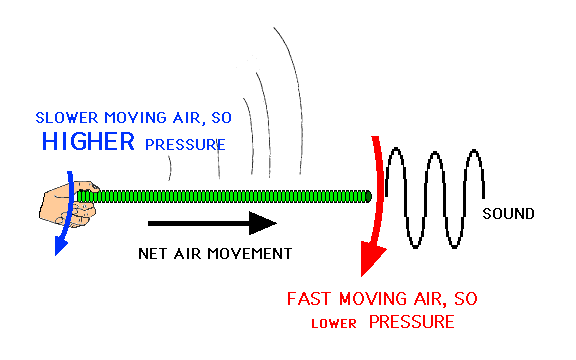Musical
Tube
SUBJECT: Aeronautics
TOPIC: Air Properties
DESCRIPTION: A whirling tube makes musical notes demonstrating the
Bernoulli Theorem.
CONTRIBUTED BY: Gregory Vogt, OSU
EDITED BY: Roger Storm, NASA Glenn Research Center
MATERIALS:
Corrugated flexible plastic tube (Corrugated tubing is available from swimming
pool supply stores. Ask for a piece about 1 meter long. Tubing is also available
from toy stores under names such as Whirl-A-Tune TM)
PROCEDURE:
1. Hold the tube at one end and twirl the other end rapidly through the air.
Make sure not to hit anything with the whirling end. A musical note will be
produced.

2. Whirl the tube at different speeds. What happens to the pitch? Why do you
think this happens?
3. Plug the end of the tube in your hand with a cloth and spin the tube. Is
a sound produced? Why or why not?
DISCUSSION:
The musical tube provides an audible demonstration of the Bernoulli Theorem.
The free end of the tube moves through the air much more rapidly than the
end in your hand. Consequently, the velocity of the air around the free end
is much greater than the velocity around the end in your hand.
Bernoulli's Theorem, in
general terms, describes the relationship in a fluid between pressure and
velocity. Where the velocity is greater, the pressure is smaller and vice
versa. The velocity of the air around the moving end of the tube is greater
and therefore the air pressure there is smaller than at the slowly moving
end. Inside the tube, the air is relatively stationary. However, a pressure
differential is created between the two ends and air flows from the slowly
moving end to the fast moving end where it spills out. The tube's corrugations
cause the air to vibrate as it travels from one end of the tube to the other.
The vibration produces the musical note. When the tube is moving faster, the
vibration frequency increases raising the pitch. When the tube is plugged,
no air flows and the sound is stopped.
The musical tube can be
used to demonstrate the same pressure changes that also take place around
an airplane’s wing. By making air flow faster over the top of a wing
than below it, a major share of aerodynamic lift is produced because the pressure
on the bottom of the wing where the air is moving slower is greater than the
pressure on the top of the wing where the air is moving faster. Thus the wing
is pushed upwards by the difference in pressure. This is lift.
Return to Aeronautics Activities
Return to Aerospace Activities Page
Bernoulli's Equation
Aerospace Education Services
Project
Oklahoma State University
